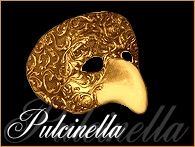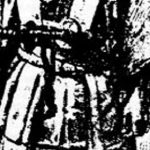by (MagicOfVenetia): Venetian masks have a long history of protecting their wearer’s identity during promiscuous or decadent activities…
Made for centuries in Venice, these distinctive masks were formed from paper-mache and wildly decorated with fur, fabric, gems, or feathers. Eventually, Venetian masks re-emerged as the emblem of Carnevale (Venetian Carnival), a pageant and street fair celebrating hedonism.
Venetian masks have been worn in Venice, Italy, since antiquity. Unlike the vast majority of their counterparts in contemporary European nations, each citizen in Venice enjoyed a high standard of living. Everyone was part of the great economic machine that was the Republic. Venice was capitalizing on its position, on its gains, long before its contemporaries had realized the value of a market economy. With a level of social wealth unequaled since, the citizens of Venice developed a unique culture—one in which the concealing of the identity in daily life became paramount to daily activity. Part of the secrecy was pragmatic: there were things to do, people to see, and perhaps you might not want others to know what deals you were cutting. After all, the city is relatively small.
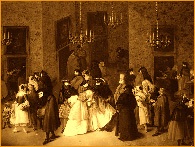 Additionally, the masks served an important social purpose of keeping every citizen on an equal playing field. Masked, a servant could be mistaken for a nobleman—or vice versa. State inquisitors and spies could question citizens without fear of their true identity being discovered (and citizens could answer without fear of retribution). The morale of the people was maintained through the use of masks—for with no faces, everyone had voices.
Additionally, the masks served an important social purpose of keeping every citizen on an equal playing field. Masked, a servant could be mistaken for a nobleman—or vice versa. State inquisitors and spies could question citizens without fear of their true identity being discovered (and citizens could answer without fear of retribution). The morale of the people was maintained through the use of masks—for with no faces, everyone had voices.
As a result of the concealment of identity, however, people naturally found themselves taking advantage of the situation. The society grew ever more decadent. The immense amount of travelers coming through the city meant that sexual promiscuity was commonplace and acceptable. Gambling went on all day and night in the streets and houses, even in convents. Women’s clothing became more revealing; homosexuality, while publicly condemned, was embraced by the populace. Even the nuns and monks of the clergy, bejeweled and dressed in the latest imported creations, wore masks and engaged in the same acts as the majority of their fellow citizens. Rome turned a blind eye, as long as the Republic continued to make generous donations.
 The Republic fell into a state of luxury, indolence, and moral decay. Eventually the wearing of masks in daily life was banned and limited only to certain months of the year. During the last year of the Republic’s existence, this period extended for over three months from December 26. After the 1100s, the masquerade went through periods of being outlawed by the Catholic Church, especially during holy days. Their policy leads to eventual acceptance when they declared the months between Christmas and Shrove Tuesday free for Venetian mask – attired decadence. This period evolved into Carnival, the pre-Lent celebration meaning, “remove meat.” Although Venetian Carnival lost popularity as Venice’s cultural production faltered during the Enlightenment, it was officially reintroduced in 1979.
The Republic fell into a state of luxury, indolence, and moral decay. Eventually the wearing of masks in daily life was banned and limited only to certain months of the year. During the last year of the Republic’s existence, this period extended for over three months from December 26. After the 1100s, the masquerade went through periods of being outlawed by the Catholic Church, especially during holy days. Their policy leads to eventual acceptance when they declared the months between Christmas and Shrove Tuesday free for Venetian mask – attired decadence. This period evolved into Carnival, the pre-Lent celebration meaning, “remove meat.” Although Venetian Carnival lost popularity as Venice’s cultural production faltered during the Enlightenment, it was officially reintroduced in 1979.
The modern celebration of Venetian Carnival has reinvigorated the art and craft of making Venetian masks. Recognizable types of Venetian masks continue to dazzle tourists, dancers, and pageant participants during Carnival and year round. Wearing Venetian masks has spread to Halloween masquerade balls and what North and South Americans call Mardi Gras, but they always carry their rich Italian history.
In general all Venetian masks may be classified under two major groups:
COMMEDIA DELL’ARTE MASKS
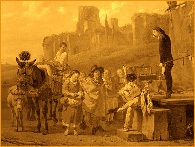 These masks date back to the second half of the sixteenth century and represent characters, ethnic traditions, professions and trades closely tied to the different cities of Italy personified by professional actors in the Commedia dell’Arte (means Art of Comedy in Italian)
These masks date back to the second half of the sixteenth century and represent characters, ethnic traditions, professions and trades closely tied to the different cities of Italy personified by professional actors in the Commedia dell’Arte (means Art of Comedy in Italian)
Commedia dell’Arte was a form of improvisational theater, which began in the 16th century and was popular until the 18th century, although it is still performed today. Traveling teams of players would set up an outdoor stage and provide amusement in the form of juggling, acrobatics, and, more typically, humorous plays based on a repertoire of established characters with a rough storyline, called Canovaccio.
Troupes occasionally would perform directly from the back of their traveling wagon, but this is more typical of Carro di Tespi, a sort of traveling theatre that dates back to antiquity.
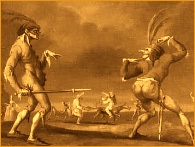 The performances were improvised around a repertory of stock conventional situations, adultery, jealousy, old age, love, some of which can be traced in Roman comedies of Plautus and Terence. The dialogue and action could easily be made topical and adjusted to satirize local scandals, current events, or regional tastes, mixed with ancient jokes and punch lines. Characters were identified by costume,masks, and even props, such as the slapstick.
The performances were improvised around a repertory of stock conventional situations, adultery, jealousy, old age, love, some of which can be traced in Roman comedies of Plautus and Terence. The dialogue and action could easily be made topical and adjusted to satirize local scandals, current events, or regional tastes, mixed with ancient jokes and punch lines. Characters were identified by costume,masks, and even props, such as the slapstick.
Male Commedia dell’Arte characters were depicted by actors wearing masks representing regions or towns. The female characters, however, were usually not masked. In fact, the roles were often played by males in women’s clothing and wigs, in travesti, as it is called.
Thus, the Commedia dell’Arte, with its stock situations and characters and improvised dialogue, has shown the way to many other forms of drama, from pantomime and Punch and Judy – which features debased forms of the commedia characters – to the modern animated cartoon, situation comedy, and even professional wrestling. The characters and tropes of the Commedia have also been used in modern novels, from sword and sorcery to literary works, notably by Michael Moorcock in his Jerry Cornelius stories that culminate with the Guardian prize-winning The Condition of Muzak.
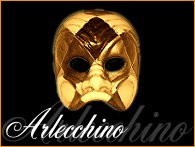 ARLECCHINO is a most popular of Zanni or comic servant characters from the Italian Commedia dell’Arte. Arlecchino traditionally wore an outfit of patches and rags, which evolved into the lozenge-shaped motley seen today. His mask was black with a large red blemish on his forehead similar to a boil.
ARLECCHINO is a most popular of Zanni or comic servant characters from the Italian Commedia dell’Arte. Arlecchino traditionally wore an outfit of patches and rags, which evolved into the lozenge-shaped motley seen today. His mask was black with a large red blemish on his forehead similar to a boil.
The primary aspect of Arlecchino was his physical agility. While generally depicted as quite stupid and greedy (in a gastronomic sense) his acrobatics were what an audience expected to see. The character would never simply perform an action when the addition of a cartwheel or back flip would spice up the movement.
Within these restrictions the character was terribly elastic. Various troupes and actors would alter his behavior to suit style, personal preferences, or even the particular scenario being performed.
He is typically cast as the servant of an innamorato or vecchio much to the detriment of his master’s plans. Arlecchino often had a love interest in the person of Colombina, and his lust for her was only superseded by his desire for food or fear of his master.
The origins of the name are uncertain. Some say it comes from Dante’s Commedia where one of devils is called Alichino. Others say it could come from Harlenkoenig, a Scandinavian hero. In another hypothesis it comes from Harlay, an English gentleman of the court of Henri III, who had protected an Italian actor.
BRIGHELLA is a comic, masked character from the Commedia dell’Arte, a money-grubbing villain and a partner of Arlecchino. His costume consisted of loosely fitting, white smock and pants with green trim and was often equipped with a battachio or slapstick. He wore a green half-mask displaying a look of preternatural lust and greed.
He is loosely categorized as one of the Zanni or servant characters though he often was portrayed as a member of the middle class such as a tavern owner. He is essentially Arlecchino’s smarter and much more vindictive older brother. As is typical of those who have risen from poverty, he is often most cruel to those beneath him on the social ladder.
He is an inveterate schemer. Frequently paired with other Zanni as his assistants or employees, Brighella’s plans were frequently foiled by their own ineptitude.
BURRATINO is a minor character from the Commedia dell’arte, one from the Zanni class.He is often not a servant, but is not well to do either. He is the quick witted earthy fellow who might be the innkeeper or grocer. If he is not a servant, he is often friends with them.
Though only mildly popular on the stage, Burrattino found his real fame in the marionette theater. According to Pierre Louis Ducharte, Burrattino puppet’s influence in Italy was so great that “by the end of the sixteenth century, all marionettes operated by strings and a wire were called burattini, instead of bagatelli or fantoccini, as they had been known up to that time.”
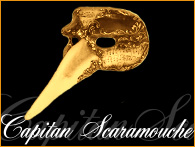 CAPITAN SCARAMOUCHE either a young man of adventure or a quite old mariner, a boasting, swashbuckling officer, often Spanish, dressed-to-kill in cape, feathered hat, high boots, with sword in belt, was always a prime favorite. He told extraordinary tales about how he beat a whole army of Turks and carried off the beard of the Sultan, but when there was a hint of real danger he was the first to run away. He made love to the none-too-innocent servant maid, and got trashed by her Harlequin lover. This character, of course, is none other than the Miles Glorious of Plautus, called in Italy Il Capitano Spavento della Valle Inferno, or simply Spavento.
CAPITAN SCARAMOUCHE either a young man of adventure or a quite old mariner, a boasting, swashbuckling officer, often Spanish, dressed-to-kill in cape, feathered hat, high boots, with sword in belt, was always a prime favorite. He told extraordinary tales about how he beat a whole army of Turks and carried off the beard of the Sultan, but when there was a hint of real danger he was the first to run away. He made love to the none-too-innocent servant maid, and got trashed by her Harlequin lover. This character, of course, is none other than the Miles Glorious of Plautus, called in Italy Il Capitano Spavento della Valle Inferno, or simply Spavento.
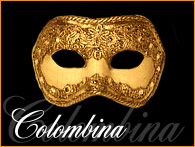 COLOMBINA (means “little dove” in Italian) is a comic servant character from the Commedia dell’Arte. Colombina was usually dressed in a ragged and patched dress appropriate to a hired servant. Occasionally, under the name Arlecchina she would wear motley similar to her counterpart Arlecchino. She was also known to wear heavy makeup around her eyes and carry a tambourine which she could use to fend off the amorous advances of Pantalone. She was often the only functional intellect on the stage. Colombina aided her mistress, the inamorata to gain the affections of her one true love by manipulating Arlecchino and counter-plotting against Pantalone while simultaneously managing the whereabouts of the inamorato.
COLOMBINA (means “little dove” in Italian) is a comic servant character from the Commedia dell’Arte. Colombina was usually dressed in a ragged and patched dress appropriate to a hired servant. Occasionally, under the name Arlecchina she would wear motley similar to her counterpart Arlecchino. She was also known to wear heavy makeup around her eyes and carry a tambourine which she could use to fend off the amorous advances of Pantalone. She was often the only functional intellect on the stage. Colombina aided her mistress, the inamorata to gain the affections of her one true love by manipulating Arlecchino and counter-plotting against Pantalone while simultaneously managing the whereabouts of the inamorato.
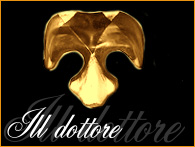 ILL DOTTORE is a local aristocrat and/or doctor of medicine or law or anything else he claims to know about, which is most things. He traditionally is portrayed as having been educated in Bologna. He is often extremely rich, generally with “old” money, though the needs of the scenario might have things otherwise. He is extremely pompous, and loves the sound of his own voice, spouting ersatz Latin and Greek. His interaction in the play is usually mostly with Pantalone, either as a friend, mentor or competitor.
ILL DOTTORE is a local aristocrat and/or doctor of medicine or law or anything else he claims to know about, which is most things. He traditionally is portrayed as having been educated in Bologna. He is often extremely rich, generally with “old” money, though the needs of the scenario might have things otherwise. He is extremely pompous, and loves the sound of his own voice, spouting ersatz Latin and Greek. His interaction in the play is usually mostly with Pantalone, either as a friend, mentor or competitor.
He is typically depicted as an elderly man who only knows nonsense. He makes many cruel jokes about the opposite sex and believes that he knows everything about everything. He is an obese man that enjoys the bottle and eating to excess. His mask is unique in that it is the only mask in Commedia dell’Arte to cover only the forehead and nose. It is sometimes black in color or else flesh-toned with a red nose.
His costume is usually all or mostly black, sometimes with a white collar. He frequently wears a hat, and long, trailing robes. If the actor playing the role is not naturally fat then he is padded out to make him seem so.
PANTALONE is a miserly, libidinous, aged character from the Commedia dell’Arte. Usually he is a shopkeeper from Vienna, somewhat stupid, fond of food and of pretty women, talkative, gullible, full of temper, and the butt of all the jokes, some of them very indecent, yet forgiving in the end.
He traditionally wears a large codpiece to advertise his virility, which everyone around him knows to be long gone.
He is often cast as the parent of one of the inamorata and has some business or personal relationship with Dottore or Capitano. Pantalone’s plans to profit at the expense of his family and friends are guaranteed to be thwarted by his servant. He traditionally wears a large codpiece to advertise his virility (which everyone around him knows to be long gone) along with a mask with a long hooked nose, a tight red vest, red breeches and stockings, a black cassock, slippers and a brimless hat.
 PIERROT (Pedrolino in his Italian incarnation) is a stock figure in the Commedia dell’Arte. Pierrot is normally portrayed as personable, charming and kind, to the point of excess he blames himself for wrongs never done and because of his good and trusting nature is often easily tricked. The noticeable feature of Pierrot’s behavior is his naiveness, he is seen as a fool, always being cheated and joked on by the others. Despite his suspicions about things, Pierrot always ends up trusting people and believing in their lies. Pierrot is also called as a lunatic, an a person outside the reality, in a state of unawareness about what’s happening around, someone for whom anything matters, just cheering and playing all the time.
PIERROT (Pedrolino in his Italian incarnation) is a stock figure in the Commedia dell’Arte. Pierrot is normally portrayed as personable, charming and kind, to the point of excess he blames himself for wrongs never done and because of his good and trusting nature is often easily tricked. The noticeable feature of Pierrot’s behavior is his naiveness, he is seen as a fool, always being cheated and joked on by the others. Despite his suspicions about things, Pierrot always ends up trusting people and believing in their lies. Pierrot is also called as a lunatic, an a person outside the reality, in a state of unawareness about what’s happening around, someone for whom anything matters, just cheering and playing all the time.
Pierrot wears white clothes, which are occasionally overlarge for him but more commonly are well fitted, and sometimes black accessories. On his head he wears a hat that is either tall and pointed or else small and brimmed. Pierrot is very occasionally depicted with a teardrop on his face, and he usually wears no mask; the actor is generally expected to have a great range of facial expression, and this tradition has been in play since at least the start of the 1600s. His face is sometimes whitened with powder or flour.
PULCINELLA is a classical character that originated in the Commedia dell’Arte of the 17th century, a hunchback who still chases women. Pulcinella was the model for Punch in the English variation Punch and Judy. Pulcinella became a stock character in Neapolitan puppetry. His main characteristic, from which he acquired his name, is his extremely long nose, which resembles a beak. In Latin, this was a pullus gallinaceus, which led to the word “Pulliciniello” and “Pulcinella”, related to the Italian pulcino or chick. His traditional temperament is to be mean, vicious, and crafty: Pulcinella main mode of defense is to pretend to be too stupid to know what’s going on, and his secondary mode is to physically beat people.
Pulcinella often wears a black mask and long white coat, and has loose and straggly hair.
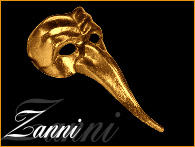 ZANNI is the archetype of the comic servant characters of the Commedia dell’arte. Its name comes from Giovanni (also said Zan, Zane, Zuane), a typical name of servants whose forefathers emigrated in Venice search for work from the valleys around Bergamo. Opposed to the Magnifici (the masters), the role of the Zanni is very changeable: silly, simple-minded, and vulgar. Once inside the city environment Zanni becomes sly, cunning, meddling, and cheeky. Many times he remains poor, constantly hungry.
ZANNI is the archetype of the comic servant characters of the Commedia dell’arte. Its name comes from Giovanni (also said Zan, Zane, Zuane), a typical name of servants whose forefathers emigrated in Venice search for work from the valleys around Bergamo. Opposed to the Magnifici (the masters), the role of the Zanni is very changeable: silly, simple-minded, and vulgar. Once inside the city environment Zanni becomes sly, cunning, meddling, and cheeky. Many times he remains poor, constantly hungry.
Zanni’s costume was loosely fitting white smock and pants. He wore a black mask reminiscent of his more popular descendant, Arlecchino.
CARNIVAL MASKSVenetian Mask is the object, which most represents Venice, because it plays the Venetian spirit projected towards the party, the transgression and the amusement. There were many occasions when people turned to dressing up, in fact masks were worn many months of the year. In the eighteenth century, Venice enjoyed the reputation of having the most famous Carnival in the world. All the social classes took part and the mask represented the trick for the expression of that big collective magic.
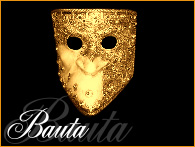 BAUTA is famous through the Carnival of Venice as it is the main type of mask worn during the Carnival. Bauta was used also on many other occasions as a device for hiding the wearer’s identity and social status. It would permit the wearer to act more freely in cases where he or she wanted to interact with other members of the society outside the bounds of identity and everyday convention. It was thus useful for a variety of purposes, some of them illicit or criminal, others just personal, such as romantic encounters.
BAUTA is famous through the Carnival of Venice as it is the main type of mask worn during the Carnival. Bauta was used also on many other occasions as a device for hiding the wearer’s identity and social status. It would permit the wearer to act more freely in cases where he or she wanted to interact with other members of the society outside the bounds of identity and everyday convention. It was thus useful for a variety of purposes, some of them illicit or criminal, others just personal, such as romantic encounters.
The name Bauta does not have up to now, a definite interpretation. It may came from the German “behten” (to protect), as well as from “bau”(or “babau”), typical Italian representation of the monster, or bad beast, used by adults to scare children. “Se non stai bravo viene il babau e ti porta via … (if you do not behave, the babau will come and take you away …)”.
This very Venetian mask was considered an ideal disguise by kings and princes who could move freely into the city without being recognized but was worn by strangers too. Fame of the Bauta went on along the Serenissima Republic, with the French and Austrian rules it started to disappear, considered as a reactionary symbol.
Bauta is quite ghostlike and with the centuries the fashion was to wear it with a black tricorno (the 3-pointed typical Venetian hat), zendale (long hood made of satin and macrame), and long cape.
 DAMA, which presents many elegant variations corresponds to the ladies of the Cinquecento (the period of Titian) who covered themselves in jewels, expensive clothing and elaborate coifs. In our days this is probably the most popular and most beautiful mask type used during the Venetian Carnival.
DAMA, which presents many elegant variations corresponds to the ladies of the Cinquecento (the period of Titian) who covered themselves in jewels, expensive clothing and elaborate coifs. In our days this is probably the most popular and most beautiful mask type used during the Venetian Carnival.
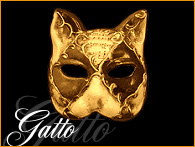 GATTO (means cat in Italian) is a traditional Venetian Carnival mask. Cats were so scarce in Venice that they became the subject of one of the most typical masks. Legend has it that a man who owned nothing but his old cat came to Venice from China. The cat rid the palace of all its mice and the man became rich. When he went back home, his rich neighbor was green with envy and rushed to Venice with his most precious silks, thinking that if a mere cat made the other man rich, he would be enormously rewarded for these precious items. Indeed, the Duke promised him his most precious possession in return for his gifts… and the neighbor went home with the cat!
GATTO (means cat in Italian) is a traditional Venetian Carnival mask. Cats were so scarce in Venice that they became the subject of one of the most typical masks. Legend has it that a man who owned nothing but his old cat came to Venice from China. The cat rid the palace of all its mice and the man became rich. When he went back home, his rich neighbor was green with envy and rushed to Venice with his most precious silks, thinking that if a mere cat made the other man rich, he would be enormously rewarded for these precious items. Indeed, the Duke promised him his most precious possession in return for his gifts… and the neighbor went home with the cat!
 JESTER, or JOLLY as a female variant, is a specific type of clown mostly associated with the Middle Ages. Starting in Italy, Jester moved into all of Europe, influencing theatre in Spain, Holland, Germany, Austria, England, and especially, France.
JESTER, or JOLLY as a female variant, is a specific type of clown mostly associated with the Middle Ages. Starting in Italy, Jester moved into all of Europe, influencing theatre in Spain, Holland, Germany, Austria, England, and especially, France.
The origins of the Jester are said to have been in prehistoric Western tribal society. Pliny the Elder mentions a royal Jester (planus regius) when recounting Apelles’ visit to the palace of the Hellenistic King Ptolemy I. However, Jesters are mainly thought of in association with the European Middle Ages. Jester was symbolic twin of the king. All Jesters and fools in those days were thought of as special cases whom God had touched with a childlike madness—a gift, or perhaps a curse. Mentally handicapped people sometimes found employment by capering and behaving in an amusing way. In the harsh world of medieval Europe, people who might not be able to survive any other way thus found a social niche.
Jesters typically wore brightly colored clothing in a motley pattern. Their hats were especially distinctive; made of cloth, they were floppy with three points, each of which had a jingle bell at the end. The three points of the hat represent the asses’ ears and tail worn by Jesters in earlier times. Other things distinctive about the jester were his incessant laughter and his mock scepter, known as a bauble or marotte.
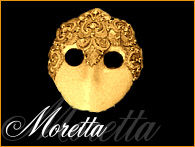 MORETTA is traditional Venetian mask. This mask was worn by Venetian women all year around. Moretta is an oval mask of black velvet that was usually worn by women visiting convents. It was invented in France and rapidly became popular in Venice as it brought out the beauty of feminine features. The mask was finished off with a veil.
MORETTA is traditional Venetian mask. This mask was worn by Venetian women all year around. Moretta is an oval mask of black velvet that was usually worn by women visiting convents. It was invented in France and rapidly became popular in Venice as it brought out the beauty of feminine features. The mask was finished off with a veil.
VOLTO (means face in Italian) also known as the Citizen mask, because it was worn by the common people during all Holidays since ancient time: S. Marco’s day, Sensa feast day, S. Vito and Modesto, S. Stefano festivities are only a few examples.
DOTTORE PESTE is a modern Venetian Carnival  mask. This mask has a very unique history. One of the worst scourges for the city of Venice was without any doubt the Plague, which struck the city on several occasions. Because of this the Plague Doctor isn’t a real mask but was a disguise used by local plague doctors who went on visits wearing this strange costume to people afflicted with plague.
mask. This mask has a very unique history. One of the worst scourges for the city of Venice was without any doubt the Plague, which struck the city on several occasions. Because of this the Plague Doctor isn’t a real mask but was a disguise used by local plague doctors who went on visits wearing this strange costume to people afflicted with plague.
Dottore Peste outfit consisted of a hat to show that the man was a doctor, a mask to protect the face which included crystal eyes to protect the wearer’s eyes and the beak which was stuffed with spices or herbs to purify the air that the doctor breathed, a wooden stick to push away victims who would get too close to him, a pair of leather gloves to protect the hands, a gown waxed from the exterior, and full length boots.











